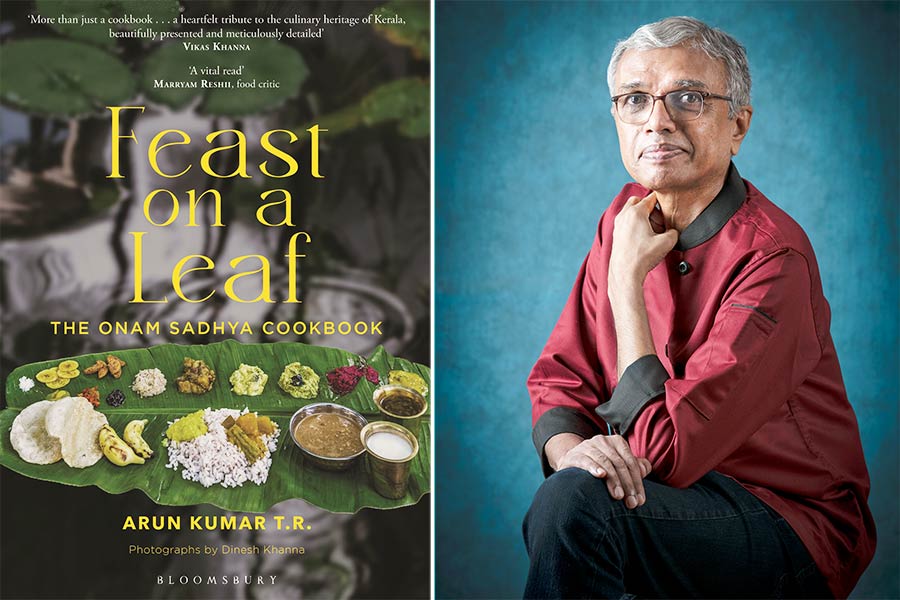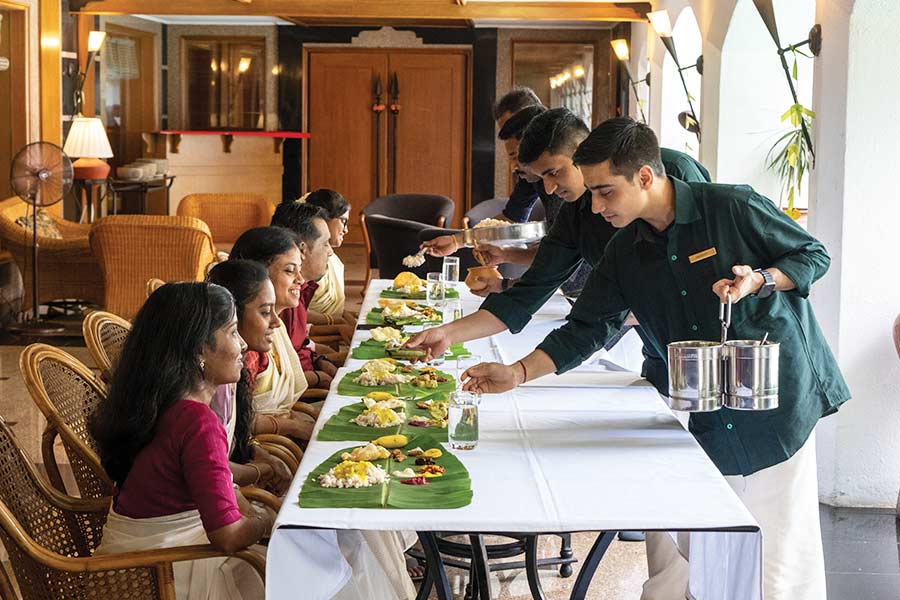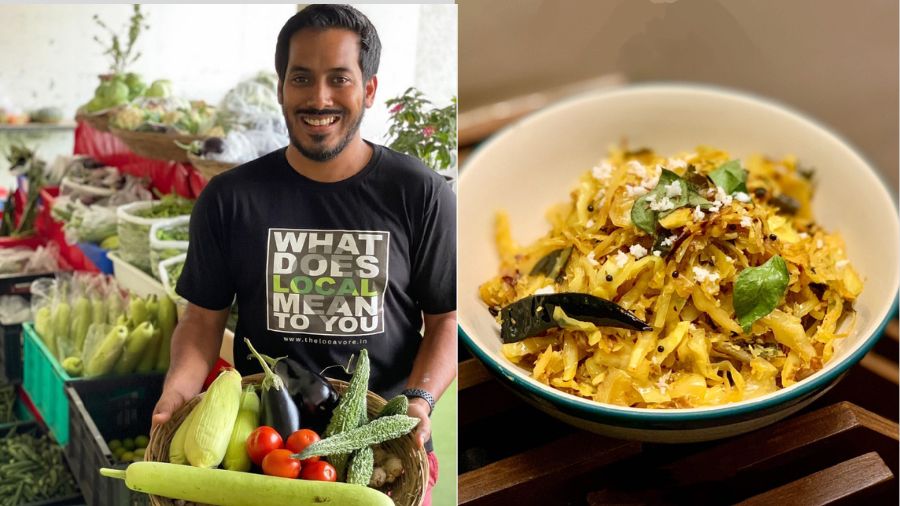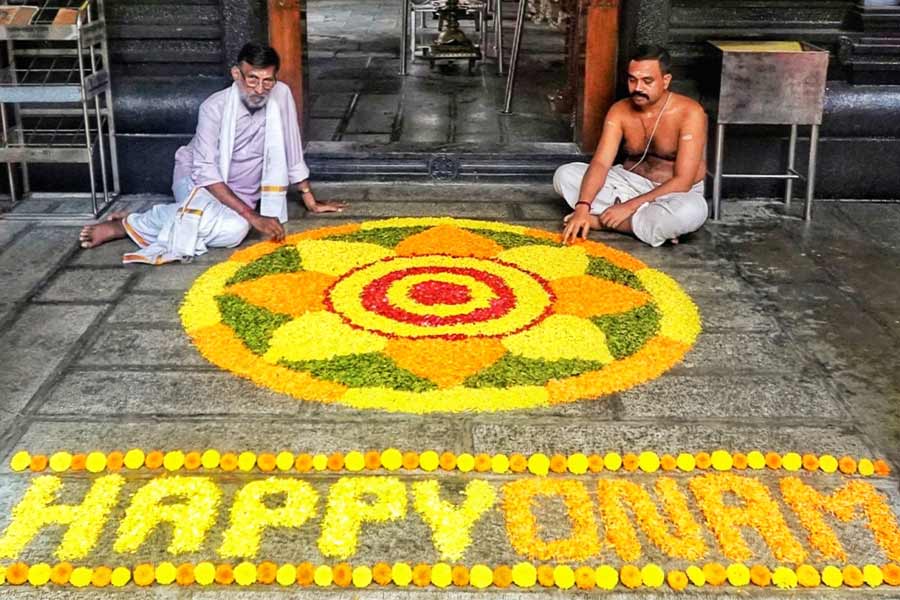One of the most elaborate traditional vegetarian meals, the sadya (or sadhya) is a mainstay of Onam celebrations. Traditionally served on a banana leaf, and with the number of dishes ranging in double digits, it is also a unique combination of flavours and textures.
In his debut book Feast on a Leaf (Bloomsbury, 2024) veteran chef Arun Kumar T.R. digs into the history, rituals and folklore around the Onam sadya. With techniques and stories from a traditional Nair tharavad kitchen — around which the chef spent his childhood — the book also has recipes for over 30 sadya dishes.
In the following excerpt from Feast on a Leaf, we look at the nuances behind serving and arranging a sadya — which dishes are served from left to right, how to go about eating a sadya meal, and more.
Left to Right, ‘Feast on a Leaf’
Serving an Onam sadhya is quite a challenge, and one which goes beyond simply cooking the twenty-four-plus dishes. If it is a family sadhya, confusion and chaos sets in from the moment you begin placing the leaves on which the meal will be served. Should the narrow tail end of the leaf be on the left or right? There is some disagreement about this. The tail end should be on the left of the person who is eating. Sometimes you do not get leaves which have a tail and a head, they are almost rectangular pieces because they have been trimmed to remove the torn portions. In this case the leaf could be placed without bothering about left and right. This was just one of the problems I faced when I managed the first Onam sadhya at the restaurant I was heading.
……
There is science and a little bit of ayurveda involved. A sadhya is a balance of six tastes: sweet, sour, salty, bitter, pungent and astringent. They are all present, some singularly and others in a mix. A sadhya is also a melody of textures, from crisp to soft to watery. Here, putting together the science, ayurveda, textures and my observations from what I have seen and been told by the elders in the family, is a largely acceptable way to serve the Onam sadhya.

Chef Arun Kumar T.R.’s debut cookbook ‘Feast on a Leaf’ delves into the history and rituals of an Onam sadya, along with over 30 traditional recipes Dinesh Khanna (book cover)
Prior to inviting people to sit for the meal, place the leaves with the tail to the left of the person eating. The left corner is for all the accompaniments: a pinch of salt, pickles, chips, a banana, ela ada/unniyappam and pappadum. Towards the right upper half put some pulli inji and inji thayir. Put a tablespoon full of payasam in the lower, right-hand corner.
Now, between these two ends, running clockwise, comes the rest. After everyone is seated, begin with the thorans, serving them in the upper part of the leaf, starting from where the chips are placed. Below this put drier preparations like avial, erissery, kootu kari and kaalan. On the right-hand side serve the runny preparations like theeyal, olan and pulissery. Leave the lower centre half for the rice.
After the rice is served, pour a few teaspoons of parippu followed by ghee. The meal begins with that. Then comes the sambar. And the sadhya is on.
On the periphery of the leaf, either above the centre or on the right, you could place buttermilk and rasam in tumblers or glasses. The payasam could also be placed in bowls next to them. For the truly deft diners all this is served on the leaf.
What you have on the leaf is an array of tastes, flavours and textures, from the salty and pungent left side to sweet and sour at the other end, with bitter and astringent in between.
In fact, when you look at the narrow left corner, you would find it packed with all the tastes: salty (salt, pickles), sweet (banana–jaggery chips, ela ada, (unniyappam), pungent and bitter (pickles), sour and astringent (pulli inji and inji thayir).
In terms of texture, you have the crisp pappadums and chips on the left, the firm but soft curries in the middle and the watery olan, pulissery and theeyal to the right. With all this left corner, right corner, centre and the centre half, it sounds like a football match!
Now everything is served. But how does one eat a sadhya? Definitely with your hands, but in what order? Traditionally, as soon as you sit down to eat, the accompaniments would already be on the leaf. Eat the chips, taste the pulli inji and inji thayir. Purists would check the payasam, a teaspoon of which would be placed along with the accompaniments. There is a little controversy regarding the first course, which is the parippu with ghee. Crush a little pappadum into this. These days the parippu is followed by sambar, but according to my aunt, Radha Thampuran, after parippu you had the erissery, kaalan, avial, olan, pachadi and pulissery along with the thorans. The last two courses before the payasams, according to her, were sambar followed by rasam. And after the payasams you had some rice with the sambaram or buttermilk. Anything more on the leaf was eaten between these dishes.

All dishes on a ‘sadya’ are arranged between the accompaniments on the left tail end of the leaf and the payasam on the right Dinesh Khanna
These days, few people venture to have rasam or sambaram with rice as it is not an easy task to handle these flowing liquids on the leaf. Remember to start with small quantities of rice. It is served continuously, as are the other items when required. There is a way to indicate you do not want to be served more, by extending your hand, palms down, over the leaf. I have tried employing this constantly, especially with liquid curries like olan, but I have been reprimanded by the person serving, asking me to remove my hand. The first serving of the dish cannot be avoided. My idea was to have the chips on the left of the leaf, a little bit of rice served in the middle with parippu and sambar and get to the payasams.
When the curries were served at home, I would see my elders dipping a finger into them as they were served and tasting them. Follow the elders and do as they do. It was exactly what we kids did when it came to consuming a sadhya. Step by step we followed their cues. If they took a bit of avial, we did the same. If they reached out to the olan, we did too. Purists would argue about the order of not just the serving of the sadhya but the order in which it is to be eaten: should the avial come first or the erissery, should the theeyal be served or placed on the leaf; what about the pulissery? There is no end to the debate. Enjoy it the way you feel.
Buy the book here



